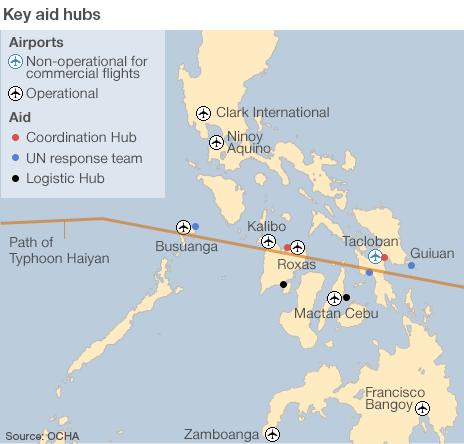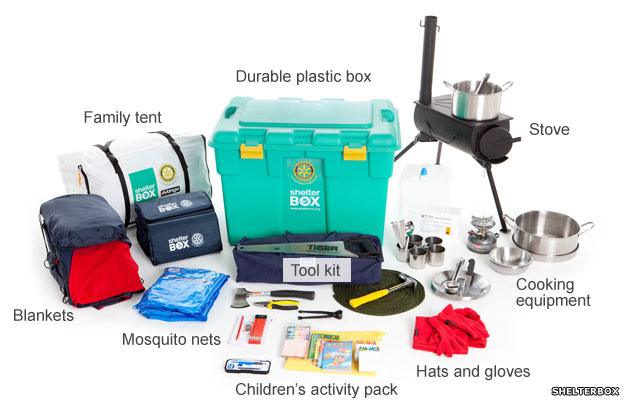Typhoon Haiyan: Aid in numbers
- Published
International governments and aid agencies are stepping up efforts to deliver urgent supplies to millions of people in the Philippines, amid criticism of the operation so far.
More than 11 million people have been affected, around 10% of the population, the UN reports.

In some towns and cities, the UN says that as much as 90% of housing has been destroyed.
The UN has issued an appeal for $300m (£190m), and has released $25 million in emergency funds to provide immediate assistance.
As of Thursday the confirmed death toll stands at 2,357, with 3,853 injured, according to the Philippines National Disaster Risk Reduction and Management Council., external (NDRRMC).
The 60-second guide: How much aid does the Philippines need?
Slow process
Damage to roads and infrastructure has hindered the distribution of aid, although US, Singaporean and Japanese military C-130 transport aircraft are now landing at Tacloban, one of the worst affected towns.
Two senior UN officials visited Tacloban on Wednesday and identified an urgent need for transport, emergency shelter material, hygiene kits, body bags and the establishment of family tracing service.
A lack of trucks and fuel shortage is severely hampering the response, the UN says, with people from remote areas forced to walk several kilometres to reach aid distribution points.

In Tacloban, bodies remain unrecovered on the streets, the UN reports.
There have also been accounts of people digging up underground pipes in a desperate search for drinking water.
Around 25 humanitarian organisations are operating in and around Tacloban, including international response teams, NGOs, the Red Cross and other UN teams.
French-Belgian and Israeli field hospitals have been set up.
The Philippines Red Cross is delivering basic food aid, which includes rice, canned goods, sugar, salt, cooking oil.

The Philippines Red Cross "Survival Tips"
If your house was destroyed, make sure that it is already safe and stable when you enter
Beware of dangerous animals such as snakes that may have entered your house
Watch out for live wires or outlet immersed in water.
Report damaged electrical cables and fallen electric posts to the authorities.
Do not let water accumulate in tyres, cans or pots to avoid creating a favourable condition for mosquito breeding.

Water and sewerage systems have been destroyed in many areas, and the UN has identified an urgent need for mobile water treatment units, generators and emergency latrines.
Although all regional airports have now reopened, Tacloban remains closed to civilian flights, the NDRRMC reports.
The Philippines Government has established additional aid distribution points in Guiuan, Eastern Samar, and Ormoc City, Leyte.
International effort
The US aircraft carrier George Washington and its escort ships have arrived off the Philippines coast.
The carrier's fleet of helicopters is desperately needed to expand search and rescue operations, and deliver aid to inaccessible areas.
A hospital ship, USNS Mercy, has also been activated and could reach the Philippines in December.
Britain has despatched the helicopter carrier HMS Illustrious from the Gulf.
It is expected to arrive in 10 days time and will relieve the destroyer HMS Daring, itself en route and due to arrive on Saturday.
The British government has also sent 8,836 shelter kits from Dubai on a chartered aircraft, which landed at the main aid distribution hub in Cebu on Wednesday.
Each kit consists of plastic sheeting and rope to provide temporary shelter for a family of five.
Several more UK-funded aid flights are expected to arrive in the next few days.
Japan is preparing to send up to 1,000 troops as well as naval vessels and aircraft.
Double blow
When the typhoon struck, the region was still reeling from the Bohol earthquake in October. More than 17,300 people were already receiving food aid from the World Food Programme as a result of the quake.
British charity ShelterBox, which provides emergency shelter and non-food supplies for families affected by disasters, was already in the region working with affected families.
ShelterBox provides families with a plastic box which contains a variety of items.
What's in a ShelterBox box?

ShelterBox volunteer Mark Dyer weathered the storm on Bohol Island.
"When we knew the typhoon was coming, we advised people to lower the tents before the storm. So we are now going back to help people put these tents back up, so they will at least have places to live for the next few weeks."
As well as a tent - designed to withstand extremes of wind, rain and cold - ShelterBox boxes include water purification equipment, blankets, cooking implements and solar-powered lighting and activity packs for children.